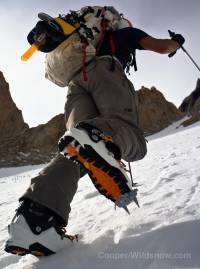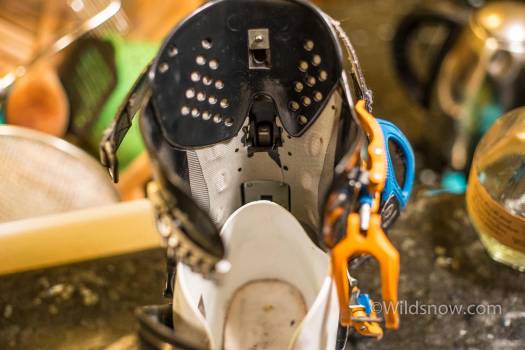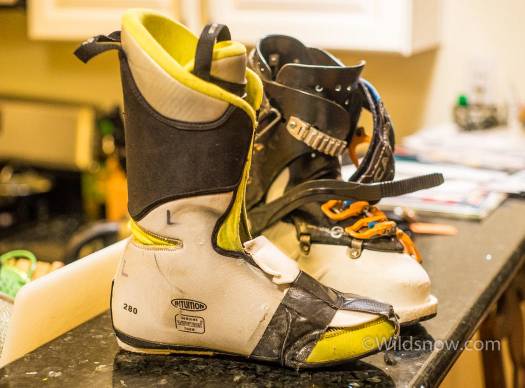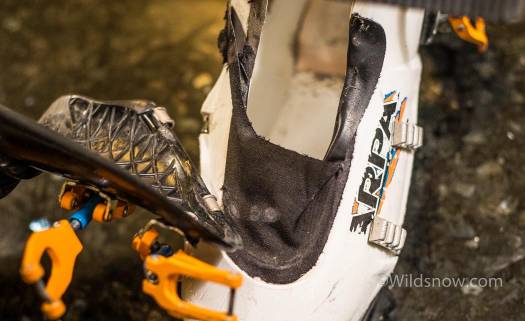
Booting a couloir in the Torres Del Paine area in southern Chile. Click to enlarge.
SCARPA has been making the Maestrale line of boots for six years, and the Maestrale RS for three. Reportedly they are the highest selling backcountry ski touring boot of all time. There’s a reason they haven’t changed much; they are incredible boots.
I skied the original Maestrales when they came out, and still do occasionally. I’ve had the RS boots for almost two years and have put quite a bit of use on them. I’ve skied them for almost every day of two seasons, from deep powder resort days to spring touring. I don’t really keep track of ski days, but they easily have over 100 days on them, more closer to 200.
Although we’ve done a few reviews of Maestrale boots on Wildsnow, we haven’t had a report on long term use. How durable are they? How do they work in a large variety of conditions? One nice thing about a product that has remained largely unchanged for several years, such as the Maestrale, is that it’s possible to buy new boots and have an idea of how they are going to last.
Maestrale RS boots aren’t the lightest or the stiffest boots out there, but they are an excellent blend of both attributes. I find myself using them for everything. They are stiff enough to drive big skis, and light enough for big days. They also fit my feet well (the most important aspect of any boot). Last but not least, they are a good value, and can often be found for a reasonable price.
I like stiff boots. Maestrales, while fairly stiff, are still a bit soft for me. I upgraded the stock Intuition Pro Tour liner with a stiffer Intuition liner stolen from SCARPA Freedoms. They now ski better. I can’t feel any difference in the walk mode flexibility, although they are slightly heavier.
SCARPA are some of the highest volume AT boots out there, and they fit me out of the box, although a bit too roomy. I heat-molded the liners, added a 3mm riser under the heel, and taped a 4mm piece of foam over the toe. They now fit well. The foam has the added benefit of making the boots slightly warmer. The advantage of a high-volume fit like SCARPAs have is that they rarely require shell work to make them fit; usually molding or modifying the liner is sufficient.
As far as durability, they’ve got normal wear and tear, but are still fully functional. Overall, they’ve held up well after hard use. I haven’t done any repairs, and I expect to keep using them for a while.
The biggest issue, common to all boots in the Maestrale series (Maestrale, Maestrale RS, Gea, and Gea RS), is the tongue hinges. The Maestrale boots have a tongue that hinges to the side, which facilitates getting in and out of the boot. The pivots are riveted to the boot, which means they don’t loosen, however they aren’t user-replaceable. On both of my boots, one out of the two pivots on each boots has snapped. I’ve noticed this has happened on several other Maestrale boots I have seen. As far as I can tell, this doesn’t affect the function of the boots much. It merely means that the tongue doesn’t fold out as nicely when you are putting the boot on. For now, it’s only a slight inconvenience, however I might experiment with fixing them at some point. With only one functioning hinge, when the other one breaks, it would be a major problem.
On the first version of the Maestrale RS, the lean lock had issues with becoming iced up in cold temperatures, and wouldn’t lock into ski mode. SCARPA completely changed the design of the lean lock, and now it works much better. I’ve used them in all conditions, including lots of cold temperatures, and never once had them ice up. The new lean lock is robust, simple, and always works. It also is easier to flip wearing gloves. As an added benefit, it seems to have less play than the previous version. Often after lots of use, the lean lock on a boot will loosen up, and not provide as solid of a lock. I’m happy to report that I haven’t had that happen on the Maestrale RS.

Overall, the boots have held up well. The Gore-tex membrane laminated to the cuff (silver fabric visible here), hasn’t been worn through.
Since the Maestrales don’t have interchangeable soles, the rubber sole durability can be a limiting factor for how long the boot will last. I’ve worn the Maestrales through dirt, rocks, and even on a few snowmobile running boards (notorious boot shredders). While they are showing some age, the soles haven’t delaminated or shown any undue wear. Compared to other boots I’ve had, the sole wear is completely acceptable.
We’re big fans of the Maestrale boots here at Wildsnow, and that remains unchanged. There are other, more specialized boots out there that do various things better. However, there are few that are as versatile and good at all-around backcountry skiing as the Scarpa Maestrale RS.
Editor’s note: Regarding the rivet issue, SCARPA has a full-service repair division in Boulder, Colorado. It can do virtually any repair to its boots (maybe the only ski boot company in North America to have these kinds of resources dedicated to service). While it is a pain to part with your boots when things break mid-season, SCARPA does repairs (like the tongue rivets) fairly quickly. Whether or not that is a warranty issue depends on wear and tear on the boot, as any product has a life span. But, point is, SCARPA can pretty much fully re-furbish a boot for someone if they want that, whether it’s a warranty issue or long-term service. The address for repairs: SCARPA North America, 3550 Frontier, Unit E, Boulder, CO 80301.
Shop for Scarpa AT boots here.
Louie Dawson earned his Bachelor Degree in Industrial Design from Western Washington University in 2014. When he’s not skiing Mount Baker or somewhere equally as snowy, he’s thinking about new products to make ski mountaineering more fun and safe.


